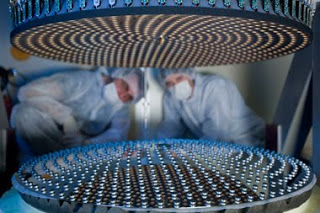Ad Support : Nano Technology Netbook Technology News Computer Software
A picture of the movable secondary mirror during its installation in the Arcetri lab. The image shows the 672 tiny magnets spread over the back of the mirror.
1. The next generation of adaptive optics has arrived at the Large Binocular Telescope (LBT) in Arizona, providing astronomers with three times the image sharpness of the Hubble Space Telescope from just one of the Ground based Telescopes. When both of the Large Binocular Telescopes have the new adaptive optics they will have ten times the image sharpness of the Hubble Space Telescope.
Going from 1% to 84% Image Perfection
The unit of measure for perfection of image quality is known as the Strehl ratio, with a ratio of 100 % equivalent to an absolutely perfect image. Without adaptive optics, the ratio for ground-based telescopes is less than 1 percent. The adaptive optics systems on other major telescopes today improve image quality up to about 30 percent to 50 percent in the near-infrared wavelengths where the testing was conducted.
In the initial testing phase, the LBT’s adaptive optics system has been able to achieve unprecedented Strehl Ratios of 60 to 80 percent, a nearly two-thirds improvement in image sharpness over other existing systems. The results exceeded all expectations and were so precise that the testing team had difficulty believing their findings. However, testing has continued since the system was first put on the sky on May 25, the LBT’s adaptive optics have functioned flawlessly and have achieved peak Strehl ratios of 82 to 84 percent.
This outstanding success was achieved through the combination of several innovative technologies. The first is the secondary mirror, which was designed from the start to be a main component of the LBT rather than an additional element as on other telescopes. The concave secondary mirror is 0.91 metres in diameter (3 feet) and only 1.6 millimetres thick. The mirror is so thin and pliable that it can easily be manipulated by actuators pushing on 672 tiny magnets glued to the back of the mirror, a configuration which offers far greater flexibility and accuracy than previous systems on other telescopes. An innovative “pyramid” sensor detects atmospheric distortions and manipulates the mirror in real time to cancel out the blurring, allowing the telescope to literally see as clearly as if there were no atmosphere. Incredibly, the mirror is capable of making adjustments every one thousandth of a second, with accuracy to better than ten nanometres (a nanometre is one millionth the size of a millimetre).
The $120 million LBT on Mount Graham utilizes two giant 8.4 metre mirrors and with the new adaptive optics the telescope will achieve the resolution of a 22.8-metre, or approximately 75-foot telescope.
Liquid mirrors are far cheaper than glass mirrors but can only point up. Put a puddle of mercury into a bowl, set it spinning and the liquid will spread out in a thin film across the surface. The result is a concave mirror with a surface so smooth that it rivals anything that astronomers can make out of glass but at a fraction of the cost.
The proof-of-principle mirror is just 5 cm across but sits atop a honeycomb of 91 actuators that can deform the liquid.
The team say they’ve found a way to cycle their actuators at rates of up to 1 Khz, much more useful than before. And they’ve overcome the the non-linear control problems by superimposing a strong uniform magnetic field on top of the field created by the actuators. This has the effect of linearising the response of the liquid.
The big advantage, of course, is that instead of having to develop their own exotic control algorithms, they can now use off-the-shelf algorithms developed for conventional adaptive optics.The result is a mirror that ought to be able to compete with the vary best conventional adaptive optics but that can be built at a fraction of the price.
Arxiv – Linearization of the response of a 91-actuator magnetic liquid deformable mirror (12 page pdf)
If you liked this article, please give it a quick review on Reddit, or StumbleUpon. Thanks
Supporting Advertising
Business Success
How to Make Money
Executive Jobs
Paid Surveys
Thank You

Brian Wang is a Futurist Thought Leader and a popular Science blogger with 1 million readers per month. His blog Nextbigfuture.com is ranked #1 Science News Blog. It covers many disruptive technology and trends including Space, Robotics, Artificial Intelligence, Medicine, Anti-aging Biotechnology, and Nanotechnology.
Known for identifying cutting edge technologies, he is currently a Co-Founder of a startup and fundraiser for high potential early-stage companies. He is the Head of Research for Allocations for deep technology investments and an Angel Investor at Space Angels.
A frequent speaker at corporations, he has been a TEDx speaker, a Singularity University speaker and guest at numerous interviews for radio and podcasts. He is open to public speaking and advising engagements.



